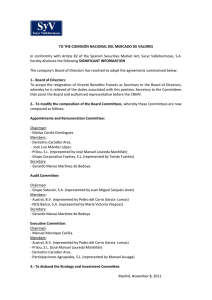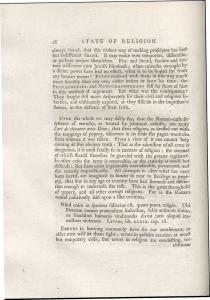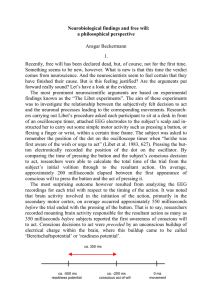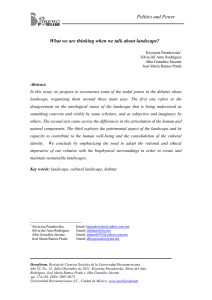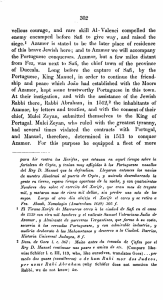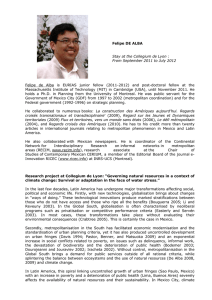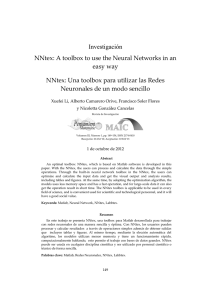Package `AMORE`
Anuncio
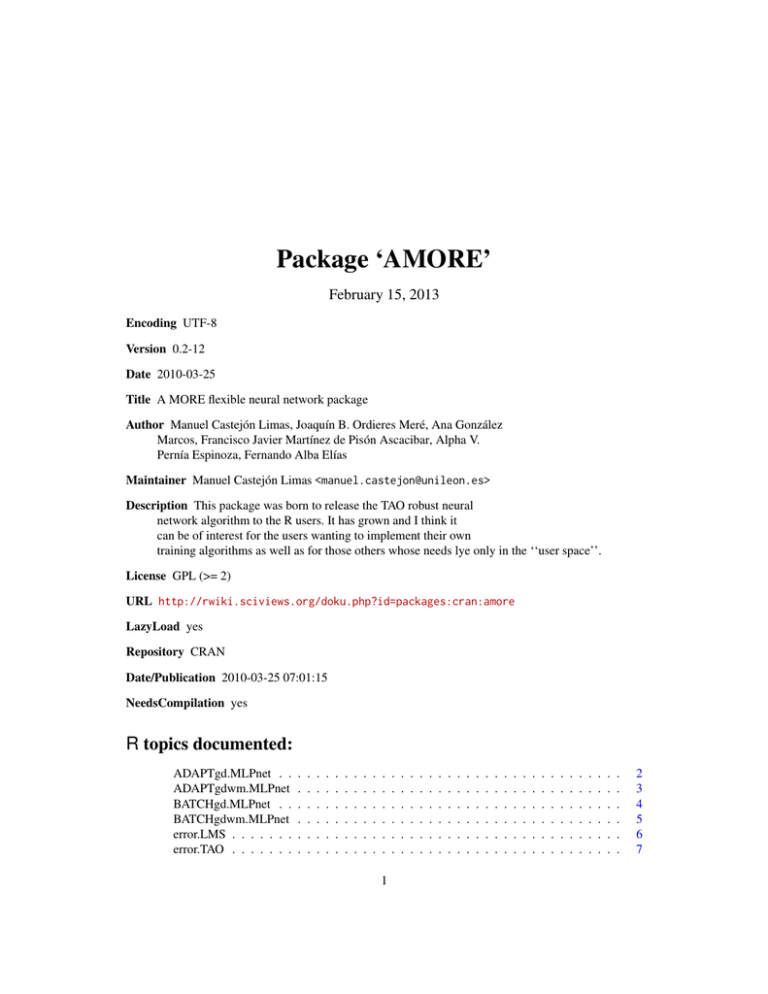
Package ‘AMORE’ February 15, 2013 Encoding UTF-8 Version 0.2-12 Date 2010-03-25 Title A MORE flexible neural network package Author Manuel Castejón Limas, Joaquín B. Ordieres Meré, Ana González Marcos, Francisco Javier Martínez de Pisón Ascacibar, Alpha V. Pernía Espinoza, Fernando Alba Elías Maintainer Manuel Castejón Limas <manuel.castejon@unileon.es> Description This package was born to release the TAO robust neural network algorithm to the R users. It has grown and I think it can be of interest for the users wanting to implement their own training algorithms as well as for those others whose needs lye only in the ‘‘user space’’. License GPL (>= 2) URL http://rwiki.sciviews.org/doku.php?id=packages:cran:amore LazyLoad yes Repository CRAN Date/Publication 2010-03-25 07:01:15 NeedsCompilation yes R topics documented: ADAPTgd.MLPnet . . ADAPTgdwm.MLPnet BATCHgd.MLPnet . . BATCHgdwm.MLPnet error.LMS . . . . . . . error.TAO . . . . . . . . . . . . . . . . . . . . . . . . . . . . . . . . . . . . . . . . . . . . . . . . . . . . . . . . . . . . . . . . . . . 1 . . . . . . . . . . . . . . . . . . . . . . . . . . . . . . . . . . . . . . . . . . . . . . . . . . . . . . . . . . . . . . . . . . . . . . . . . . . . . . . . . . . . . . . . . . . . . . . . . . . . . . . . . . . . . . . . . . . . . . . . . . . . . . . . . . . . . . . . . . . . . . . . . . . . . . 2 3 4 5 6 7 2 ADAPTgd.MLPnet graphviz.MLPnet . . . . init.MLPneuron . . . . . newff . . . . . . . . . . random.init.MLPnet . . . random.init.MLPneuron select.activation.function sim.MLPnet . . . . . . . train . . . . . . . . . . . training.report . . . . . . . . . . . . . . . . . . . . . . . . . . . . . . . . . . . . . . . . . . . . . . . . . . . . . . . . . . . . . . . . . . . . . . . . . . . . . . . . . . . . . . . . . . . . . . . . . . . . . . . . . . . . . . . . . . . . . . . . . . . . . . . . . . . . . . . . . . . . . . . . . . . . . . . . . . . . . . . . . . . . . . . . Index ADAPTgd.MLPnet . . . . . . . . . . . . . . . . . . . . . . . . . . . . . . . . . . . . . . . . . . . . . . . . . . . . . . . . . . . . . . . . . . . . . . . . . . . . . . . . . . . . . . . . . . . . . . . . . . . . . . . . . . . . . . . . . . . . . . . . . . . . . . . . . . . . . . . . . . . . . . . . 8 9 11 13 13 14 15 16 18 19 Adaptative gradient descent training Description Adaptative gradient descent training method. Usage ADAPTgd.MLPnet(net,P, T,n.epochs) Arguments net Neural Network to train. P Input data set. T Target output data set. n.epochs Number of epochs to train Value This function returns a neural network object modified according to the input and target data set. Author(s) Manuel Castejón Limas. <manuel.castejon@unileon.es> Joaquin Ordieres Meré. <j.ordieres@upm.es> Ana González Marcos. <ana.gonzalez@unirioja.es> Alpha V. Pernía Espinoza. <alpha.pernia@unirioja.es> Francisco Javier Martinez de Pisón. <fjmartin@unirioja.es> Fernando Alba Elías. <fernando.alba@unavarra.es> ADAPTgdwm.MLPnet 3 References Simon Haykin. Neural Networks – a Comprehensive Foundation. Prentice Hall, New Jersey, 2nd edition, 1999. ISBN 0-13-273350-1. See Also newff,train,ADAPTgdwm.MLPnet ADAPTgdwm.MLPnet Adaptative gradient descent with momentum training Description Adaptative gradient descent with momentum training method. Usage ADAPTgdwm.MLPnet(net,P, T,n.epochs) Arguments net P T n.epochs Neural Network to train. Input data set. Target output data set. Number of epochs to train Value This function returns a neural network object modified according to the input and target data set. Author(s) Manuel Castejón Limas. <manuel.castejon@unileon.es> Joaquin Ordieres Meré. <j.ordieres@upm.es> Ana González Marcos. <ana.gonzalez@unirioja.es> Alpha V. Pernía Espinoza. <alpha.pernia@unirioja.es> Francisco Javier Martinez de Pisón. <fjmartin@unirioja.es> Fernando Alba Elías. <fernando.alba@unavarra.es> References Simon Haykin. Neural Networks – a Comprehensive Foundation. Prentice Hall, New Jersey, 2nd edition, 1999. ISBN 0-13-273350-1. 4 BATCHgd.MLPnet See Also newff,train,ADAPTgd.MLPnet BATCHgd.MLPnet Batch gradient descent training Description Modifies the neural network weights and biases according to the training set. Usage BATCHgd.MLPnet(net,P,T,n.epochs) Arguments net Neural Network to train. P Input data set. T Target output data set. n.epochs Number of epochs to train Value This function returns a neural network object modified according to the chosen data. Author(s) Manuel Castejón Limas. <manuel.castejon@unileon.es> Joaquin Ordieres Meré. <j.ordieres@upm.es> Ana González Marcos. <ana.gonzalez@unirioja.es> Alpha V. Pernía Espinoza. <alpha.pernia@unirioja.es> Francisco Javier Martinez de Pisón. <fjmartin@unirioja.es> Fernando Alba Elías. <fernando.alba@unavarra.es> References Simon Haykin. Neural Networks – a Comprehensive Foundation. Prentice Hall, New Jersey, 2nd edition, 1999. ISBN 0-13-273350-1. See Also newff,train,BATCHgdwm.MLPnet BATCHgdwm.MLPnet BATCHgdwm.MLPnet 5 Batch gradient descent with momentum training Description Modifies the neural network weights and biases according to the training set. Usage BATCHgdwm.MLPnet(net,P,T, n.epochs) Arguments net Neural Network to train. P Input data set. T Target output data set. n.epochs Number of epochs to train Value This functions returns a neural network object modified according to the chosen data. Author(s) Manuel Castejón Limas. <manuel.castejon@unileon.es> Joaquin Ordieres Meré. <j.ordieres@upm.es> Ana González Marcos. <ana.gonzalez@unirioja.es> Alpha V. Pernía Espinoza. <alpha.pernia@unirioja.es> Francisco Javier Martinez de Pisón. <fjmartin@unirioja.es> Fernando Alba Elías. <fernando.alba@unavarra.es> References Simon Haykin. Neural Networks – a Comprehensive Foundation. Prentice Hall, New Jersey, 2nd edition, 1999. ISBN 0-13-273350-1. See Also newff,train,BATCHgd.MLPnet 6 error.LMS error.LMS Neural network training error criteria. Description The error functions calculate the goodness of fit of a neural network according to certain criterium: • LMS: Least Mean Squares Error. • LMLS: Least Mean Log Squares minimization. • TAO: TAO error minimization. The deltaE functions calculate the influence functions of their error criteria. Usage error.LMS(arguments) error.LMLS(arguments) error.TAO(arguments) deltaE.LMS(arguments) deltaE.LMLS(arguments) deltaE.TAO(arguments) Arguments arguments List of arguments to pass to the functions. • The first element is the prediction of the neuron. • The second element is the corresponding component of the target vector. • The third element is the whole net. This allows the TAO criterium to know the value of the S parameter and eventually ( next minor update) will allow the user to apply regularization criteria. Value This functions return the error and influence function criteria. Author(s) Manuel Castejón Limas. <manuel.castejon@unileon.es> Joaquin Ordieres Meré. <j.ordieres@upm.es> Ana González Marcos. <ana.gonzalez@unirioja.es> Alpha V. Pernía Espinoza. <alpha.pernia@unirioja.es> Francisco Javier Martinez de Pisón. <fjmartin@unirioja.es> Fernando Alba Elías. <fernando.alba@unavarra.es> error.TAO 7 References Pernía Espinoza, A.V., Ordieres Meré, J.B., Martínez de Pisón, F.J., González Marcos, A. TAOrobust backpropagation learning algorithm. Neural Networks. Vol. 18, Issue 2, pp. 191–204, 2005. Simon Haykin. Neural Networks – a Comprehensive Foundation. Prentice Hall, New Jersey, 2nd edition, 1999. ISBN 0-13-273350-1. See Also train error.TAO TAO robust error criterium auxiliar functions. Description Auxiliar functions. Not meant to be called from the user but from the error.TAO and the deltaE.TAO functions. Usage hfun(v,k) phifun(v,k) dphifun(v,k) Arguments v Input value. k Threshold limit. Value These functions return a numeric array with dimension equal to the dimension of v. Author(s) Manuel Castejón Limas. <manuel.castejon@unileon.es> Joaquin Ordieres Meré. <j.ordieres@upm.es> Ana González Marcos. <ana.gonzalez@unirioja.es> Alpha V. Pernía Espinoza. <alpha.pernia@unirioja.es> Francisco Javier Martinez de Pisón. <fjmartin@unirioja.es> Fernando Alba Elías. <fernando.alba@unavarra.es> 8 graphviz.MLPnet References Pernía Espinoza, A.V., Ordieres Meré, J.B., Martínez de Pisón, F.J., González Marcos, A. TAOrobust backpropagation learning algorithm. Neural Networks. Vol. 18, Issue 2, pp. 191–204, 2005. Simon Haykin. Neural Networks – a Comprehensive Foundation. Prentice Hall, New Jersey, 2nd edition, 1999. ISBN 0-13-273350-1. See Also train graphviz.MLPnet Neural network graphic representation Description Creates a dot file, suitable to be processed with graphviz, containing a graphical representation of the netwok topology and some numerical information about the network parameters. Usage graphviz.MLPnet(net, filename, digits) Arguments net Neural Network. filename Name of the dot file to be written. digits Number of digits used to round the parameters. Value This function writes a file suitable to be postprocessed with the graphviz package. Thus, multiple formats can be obtained: ps, pdf, ... Author(s) Manuel Castejón Limas. <manuel.castejon@unileon.es> Joaquin Ordieres Meré. <j.ordieres@upm.es> Ana González Marcos. <ana.gonzalez@unirioja.es> Alpha V. Pernía Espinoza. <alpha.pernia@unirioja.es> Francisco Javier Martinez de Pisón. <fjmartin@unirioja.es> Fernando Alba Elías. <fernando.alba@unavarra.es> init.MLPneuron 9 References http:\/\/www.graphviz.org init.MLPneuron Neuron constructor. Description Creates a neuron according to the structure established by the AMORE package standard. Usage init.MLPneuron(id, type, activation.function, output.links, output.aims, input.links, weights, bias, Arguments id Numerical index of the neuron (so as to be refered in a network operation). type Either hidden or ouput, according to the layer the neuron belongs to. activation.function The name of the characteristic function of the neuron. It can be "pureline", "tansig", "sigmoid" or even "custom" in case that the user wants to configure its own activation function accordingly defining f0 and f1. output.links The id’s of the neurons that accept the output value of this neuron as an input. output.aims The location of the output of the neuron in the input set of the addressed neuron. Gives answer to: Is this output the first, the second, the third, ..., input at the addressed neuron?. Similarly for an output neuron: Is this output the first, the second, the third, ..., element of the output vector? input.links The id’s of the neurons whose outputs work as inputs for this neuron. Positive values represent that we take the outputs of other neurons as inputs. Negative values represent the coordinates of the input vector to be considered as inputs. weights The multiplying factors of the input values. bias The bias summed to the weighted sum of the inputs. method Prefered training method. Currently it can be: • "ADAPTgd": Adaptative gradient descend. • "ADAPTgdwm": Adaptative gradient descend with momentum. • "BATCHgd": BATCH gradient descend. • "BATCHgdwm": BATCH gradient descend with momentum. method.dep.variables Variables used by the training methods: • ADAPTgd method: – delta: Used in the backpropagation method. 10 init.MLPneuron – learning.rate: Learning rate parameter. Notice that we can use a different rate for each neuron. • ADAPTgdwm method: – delta: Used in the backpropagation method. – learning.rate: Learning rate parameter. Notice that we can use a different rate for each neuron. – momentum: Momentum constant used in the backpropagation with momentum learning criterium. – former.weight.change: Last increment in the weight parameters. Used by the momentum training technique. – former.bias.change: Last increment in the bias parameter. Used by the momentum training technique. • BATCHgd method: – delta: Used in the backpropagation method. – learning.rate: Learning rate parameter. Notice that we can use a different rate for each neuron. – sum.delta.x: Used as an acumulator of the changes to apply to the weight parameters in the batch training. – sum.delta.bias: Used as an acumulator of the changes to apply to the bias parameters in the batch training. • BATCHgdwm method: – delta: Used in the backpropagation method. – learning.rate: Learning rate parameter. Notice that we can use a different rate for each neuron. – sum.delta.x: Used as an acumulator of the changes to apply to the weight parameters in the batch training. – sum.delta.bias: Used as an acumulator of the changes to apply to the bias parameters in the batch training. – momentum: Momentum constant used in the backpropagation with momentum learning criterium. – former.weight.change: Last increment in the weight parameters. Used by the momentum training technique. – former.bias.change: Last increment in the bias parameter. Used by the momentum training technique. Value init.MLPneuron returns a single neuron. Mainly used to create a neural network object. Author(s) Manuel Castejón Limas. <manuel.castejon@unileon.es> Joaquin Ordieres Meré. <j.ordieres@upm.es> Ana González Marcos. <ana.gonzalez@unirioja.es> Alpha V. Pernía Espinoza. <alpha.pernia@unirioja.es> Francisco Javier Martinez de Pisón. <fjmartin@unirioja.es> newff 11 Fernando Alba Elías. <fernando.alba@unavarra.es> See Also newff, random.init.MLPnet, random.init.MLPneuron, select.activation.function , init.MLPneuron Create a Multilayer Feedforward Neural Network newff Description Creates a feedforward artificial neural network according to the structure established by the AMORE package standard. Usage newff(n.neurons, learning.rate.global, momentum.global, error.criterium, Stao, hidden.layer, output. Arguments Numeric vector containing the number of neurons of each layer. The first element of the vector is the number of input neurons, the last is the number of output neurons and the rest are the number of neuron of the different hidden layers. learning.rate.global Learning rate at which every neuron is trained. momentum.global Momentum for every neuron. Needed by several training methods. error.criterium Criterium used to measure to proximity of the neural network prediction to its target. Currently we can choose amongst: n.neurons • "LMS": Least Mean Squares. • "LMLS": Least Mean Logarithm Squared (Liano 1996). • "TAO": TAO Error (Pernia, 2004). Stao Stao parameter for the TAO error criterium. Unused by the rest of criteria. hidden.layer Activation function of the hidden layer neurons. Available functions are: • • • • • output.layer "purelin". "tansig". "sigmoid". "hardlim". "custom": The user must manually define the f0 and f1 elements of the neurons. Activation function of the hidden layer neurons according to the former list shown above. 12 newff method Prefered training method. Currently it can be: • • • • "ADAPTgd": Adaptative gradient descend. "ADAPTgdwm": Adaptative gradient descend with momentum. "BATCHgd": BATCH gradient descend. "BATCHgdwm": BATCH gradient descend with momentum. Value newff returns a multilayer feedforward neural network object. Author(s) Manuel Castejón Limas. <manuel.castejon@unileon.es> Joaquin Ordieres Meré. Ana González Marcos. Alpha V. Pernía Espinoza. Eliseo P. Vergara Gonzalez. Francisco Javier Martinez de Pisón. Fernando Alba Elías. References Pernía Espinoza, A.V., Ordieres Meré, J.B., Martínez de Pisón, F.J., González Marcos, A. TAOrobust backpropagation learning algorithm. Neural Networks. Vol. 18, Issue 2, pp. 191–204, 2005. Simon Haykin. Neural Networks – a Comprehensive Foundation. Prentice Hall, New Jersey, 2nd edition, 1999. ISBN 0-13-273350-1. See Also init.MLPneuron, random.init.MLPnet, random.init.MLPneuron, select.activation.function Examples #Example 1 library(AMORE) # P is the input vector P <- matrix(sample(seq(-1,1,length=1000), 1000, replace=FALSE), ncol=1) # The network will try to approximate the target P^2 target <- P^2 # We create a feedforward network, with two hidden layers. # The first hidden layer has three neurons and the second has two neurons. # The hidden layers have got Tansig activation functions and the output layer is Purelin. net <- newff(n.neurons=c(1,3,2,1), learning.rate.global=1e-2, momentum.global=0.5, error.criterium="LMS", Stao=NA, hidden.layer="tansig", output.layer="purelin", method="ADAPTgdwm") result <- train(net, P, target, error.criterium="LMS", report=TRUE, show.step=100, n.shows=5 ) y <- sim(result$net, P) plot(P,y, col="blue", pch="+") points(P,target, col="red", pch="x") random.init.MLPnet 13 random.init.MLPnet Initialize the network with random weigths and biases. Description Provides random values to the network weights and biases so as to start with. Basically it applies the random.init.MLPneuron function to every neuron in the network. Usage random.init.MLPnet(net) Arguments net The neural network object Value random.init.MLPnet returns the input network with weights and biases changed randomly. Author(s) Manuel Castejón Limas. <manuel.castejon@unileon.es> Joaquin Ordieres Meré. <j.ordieres@upm.es> Ana González Marcos. <ana.gonzalez@unirioja.es> Alpha V. Pernía Espinoza. <alpha.pernia@unirioja.es> Francisco Javier Martinez de Pisón. <fjmartin@unirioja.es> Fernando Alba Elías. <fernando.alba@unavarra.es> See Also random.init.MLPneuron, init.MLPneuron, newff random.init.MLPneuron Initialize the neuron with random weigths and bias. Description Provides random values to the neuron weights and bias so as to start with. It is usually called by the random.init.NeuralNet function during the construction of the neural object by the newff function. Usage random.init.MLPneuron(net.number.weights, neuron) 14 select.activation.function Arguments net.number.weights Number of bias and weight parameters of the neural network the neuron belongs to. neuron The neuron object. Details The values are assigned according to the suggestions of Haykin. Value random.init.MLPneuron returns the input neuron with bias and weights changed randomly. Author(s) Manuel Castejón Limas. <manuel.castejon@unileon.es> Joaquin Ordieres Meré. <j.ordieres@upm.es> Ana González Marcos. <ana.gonzalez@unirioja.es> Alpha V. Pernía Espinoza. <alpha.pernia@unirioja.es> Francisco Javier Martinez de Pisón. <fjmartin@unirioja.es> Fernando Alba Elías. <fernando.alba@unavarra.es> References Simon Haykin. Neural Networks – a Comprehensive Foundation. Prentice Hall, New Jersey, 2nd edition, 1999. ISBN 0-13-273350-1. See Also random.init.MLPnet, init.MLPneuron, newff select.activation.function Provides R code of the selected activation function. Description Provides random values to the neuron weights and bias so as to start with. It is usually called by the random.init.NeuralNet function during the construction of the neural object by the newff function. Usage select.activation.function(activation.function) sim.MLPnet 15 Arguments activation.function Activation function name. Currently the user may choose amongst purelin, tansig, sigmoid, hardlim and custom. If custom is chosen the the user must manually assign the neuron f0 and f1 functions. Value select.activation.function returns a list with two elements. The first, f0 is the R code selected to serve as the neuron activation function. The second, f1 is the R code of the activation function derivative. Author(s) Manuel Castejón Limas. <manuel.castejon@unileon.es> Joaquin Ordieres Meré. <j.ordieres@upm.es> Ana González Marcos. <ana.gonzalez@unirioja.es> Alpha V. Pernía Espinoza. <alpha.pernia@unirioja.es> Francisco Javier Martinez de Pisón. <fjmartin@unirioja.es> Fernando Alba Elías. <fernando.alba@unavarra.es> See Also init.MLPneuron, newff Performs the simulation of a neural network from an input data set. sim.MLPnet Description This function calculates the output values of the neural network for a given data set. Various versions are provided according to different degrees of C code conversion. The sim.MLPnet function is the latest and quickest. Usage sim(net,P,...) sim.MLPnet(net,P,...) Arguments ... Currently, the parameters below are accepted. net Neural Network to simulate. P Data Set input values. 16 train Value This function returns a matrix containing the output values of the neural network for the given data set. Author(s) Manuel Castejón Limas. <manuel.castejon@unileon.es> Joaquin Ordieres Meré <j.ordieres@upm.es> Ana González Marcos. <ana.gonzalez@unirioja.es> Alpha V. Pernía Espinoza. <alpha.pernia@unirioja.es> Francisco Javier Martinez de Pisón <fjmartin@unirioja.es> Fernando Alba Elías. <fernando.alba@unavarra.es> References Simon Haykin. Neural Networks – a Comprehensive Foundation. Prentice Hall, New Jersey, 2nd edition, 1999. ISBN 0-13-273350-1. See Also newff,train train Neural network training function. Description For a given data set (training set), this function modifies the neural network weights and biases to approximate the relationships amongst variables present in the training set. These may serve to satisfy several needs, i.e. fitting non-linear functions. Usage train(net, P, T, Pval=NULL, Tval=NULL, error.criterium="LMS", report=TRUE, n.shows, show.step, Stao= Arguments net Neural Network to train. P Training set input values. T Training set output values Pval Validation set input values for optional early stopping. Tval Validation set output values for optional early stopping. train 17 error.criterium Criterium used to measure the goodness of fit:"LMS", "LMLS", "TAO". Stao Initial value of the S parameter used by the TAO algorithm. report Logical value indicating whether the training function should keep quiet or should provide graphical/written information during the training process instead. n.shows Number of times to report (if report is TRUE). The total number of training epochs is n.shows times show.step. show.step Number of epochs to train non-stop until the training function is allow to report. prob Vector with the probabilities of each sample so as to apply resampling training. Value This function returns a list with two elements: the trained Neural Network object with weights and biases adjusted by the adaptative backpropagation with momentum method and a matrix with the errors obtained during the training. If the validation set is provided, the early stopping technique is applied. Author(s) Manuel Castejón Limas. <manuel.castejon@unileon.es> Joaquin Ordieres Meré <j.ordieres@upm.es> Ana González Marcos. <ana.gonzalez@unirioja.es> Alpha V. Pernía Espinoza. <alpha.pernia@unirioja.es> Francisco Javier Martinez de Pisón. <fjmartin@unirioja.es> Fernando Alba Elías. <fernando.alba@unavarra.es> References Pernía Espinoza, A.V., Ordieres Meré, J.B., Martínez de Pisón, F.J., González Marcos, A. TAOrobust backpropagation learning algorithm. Neural Networks. Vol. 18, Issue 2, pp. 191–204, 2005. Simon Haykin. Neural Networks – a Comprehensive Foundation. Prentice Hall, New Jersey, 2nd edition, 1999. ISBN 0-13-273350-1. See Also newff 18 training.report training.report Neural network training report generator function. Description Function in charge of reporting the behavior of the network training. The users should modify this function according to their needs. Usage training.report(net,P,T, idx.show, error.criterium) Arguments net Neural Network to train. P Training set input values. T Training set output values idx.show Current show index. error.criterium Criterium used to measure the goodness of fit. Value This function does not return any value. Just useful for printing and plotting. Author(s) Manuel Castejón Limas. <manuel.castejon@unileon.es> Joaquin Ordieres Meré. <j.ordieres@upm.es> Ana González Marcos. <ana.gonzalez@unirioja.es> Alpha V. Pernía Espinoza. <alpha.pernia@unirioja.es> Francisco Javier Martinez de Pisón. <fjmartin@unirioja.es> Fernando Alba Elías. <fernando.alba@unavarra.es> References Simon Haykin. Neural Networks – a Comprehensive Foundation. Prentice Hall, New Jersey, 2nd edition, 1999. ISBN 0-13-273350-1. See Also train Index ∗Topic neural ADAPTgd.MLPnet, 2 ADAPTgdwm.MLPnet, 3 BATCHgd.MLPnet, 4 BATCHgdwm.MLPnet, 5 error.LMS, 6 error.TAO, 7 graphviz.MLPnet, 8 init.MLPneuron, 9 newff, 11 random.init.MLPnet, 13 random.init.MLPneuron, 13 select.activation.function, 14 sim.MLPnet, 15 train, 16 training.report, 18 phifun (error.TAO), 7 random.init.MLPnet, 11, 12, 13, 14 random.init.MLPneuron, 11–13, 13 select.activation.function, 11, 12, 14 sim (sim.MLPnet), 15 sim.MLPnet, 15 train, 3–5, 7, 8, 16, 16, 18 training.report, 18 ADAPTgd.MLPnet, 2, 4 ADAPTgdwm.MLPnet, 3, 3 BATCHgd.MLPnet, 4, 5 BATCHgdwm.MLPnet, 4, 5 deltaE.LMLS (error.LMS), 6 deltaE.LMS (error.LMS), 6 deltaE.TAO, 7 deltaE.TAO (error.LMS), 6 dphifun (error.TAO), 7 error.LMLS (error.LMS), 6 error.LMS, 6 error.TAO, 7, 7 error.TAO (error.LMS), 6 graphviz.MLPnet, 8 hfun (error.TAO), 7 init.MLPneuron, 9, 11–15 newff, 3–5, 11, 11, 13–17 19

